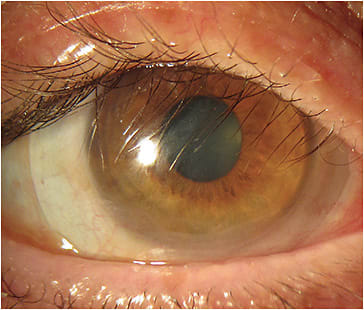Lenses can provide a barrier of protection for the ocular surface
Ocular surface disease (OSD) can manifest as dry eye disease (DED) or secondary to systemic diseases, including Sjögren’s syndrome, ocular graft-versus-host-disease, Stevens-Johnson syndrome and ocular cicatricial pemphigoid. Patients with OSD can develop trichiasis or distichiasis of the lids. Effects on the conjunctiva include injection, fibrosis and symblepharon. Corneal effects include keratitis, vascularization and scarring. These sequelae have the potential to result in patients suffering from irritation, pain and visual loss.
CONTACT LENSES AS A THERAPY
The 2017 TFOS DEWS II re-port lists a series of four stages for the management of DED.1 Stage 3 includes the use of contact lenses, including soft and scleral lenses. The role of contact lenses for the management of OSD is primarily protection of the compromised ocular surface. This includes protection from the lids (Figure 1). It also includes protection from atmospheric exposure that leads to patients’ symptoms. The second way that contact lenses aid patients who have OSD is by providing visual improvement. Additionally, contact lenses can be a viable alternative to tarsorrhaphy.

Soft contact lenses. It isn’t always obvious that a practitioner would recommend bandage soft lenses for patients who have OSD, especially if DED is the primary component. This is due mostly to the fact that we have patients who routinely fail in corrective soft lenses because of dryness. However, soft lenses, in certain cases, can effectively bandage the ocular surface, providing significant relief.
In most cases, the patient will be wearing the lenses on an extended wear basis to maximize protection and prevent disruption with more frequent replacement. It’s recommended to use an FDA-approved bandage lens design and to take advantage of silicone hydrogel materials to maximize oxygen transmissibility. Note that some of these patients will require office visits for professional lens replacement because of their inability to successfully remove and apply lenses. The practitioner and the patient have to weigh the increased risk of microbial keratitis that can come with extended wear use. In some instances, a prophylactic antibiotic can be prescribed. When choosing this treatment program, closely monitor the patient for secondary contact complications.
Scleral lenses. Scleral lenses have become the contact lens of choice for most practitioners managing severe OSD: A survey of scleral lens practitioners found that 16% of scleral lenses are prescribed for managing OSD.2,3 The rigid nature of these lenses provides protection, and the liquid reservoir that scleral lenses hold continuously bathes the anterior ocular surface.
Additionally, the roughened epithelial surface of a patient who has OSD often reduces VA. Scleral lenses are able to mask this irregularity and, in many cases, improve the patient’s functional vision.
It’s important to note that, by nature, patients who have OSD could have difficulty wetting the surface of a scleral lens, therefore consider requesting Tangible Hydra-PEG surface treatment that will improve comfort and vision.4 Additionally, make sure to keep all solutions preservative free, especially the filling solution, to prevent corneal toxicity.
CRITICAL TO HEALING
Contact lenses can be a critical component to managing moderate to severe OSD. Patients who have significant corneal epitheliopathy may benefit from extended-wear soft contact lenses. For severe cases, scleral lenses will provide patients with the most restoration, relief and improved VA. OM
REFERENCES
- Craig JP, Nelson JD, Azar DT, et al. TFOS DEWS II Report Executive Summary. Ocul Surf. 2017 Oct;15(4):802-812. doi: 10.1016/j.jtos.2017.08.003. Epub 2017 Aug 8.
- Harthan JS, Shorter E. Therapeutic uses of scleral contact lenses for ocular surface disease: patient selection and special considerations. Clin Optom (Auckl). 2018 Jul 11;10:65-74. doi: 10.2147/OPTO.S144357.
- Nau CB, Harthan J, Shorter E, Barr, et al. Demographic Characteristics and Prescribing Patterns of Scleral Lens Fitters: The SCOPE Study. Eye Contact Lens. 2018 Sep;44 Suppl 1:S265-S272. doi: 10.1097/ICL.0000000000000399.
- CV Mickles, JS Harthan, M Barnett. Assessment of a Novel Lens Surface Treatment for Scleral Lens Wearers With Dry Eye. Eye & Contact Lens. 2020;00 1-6.




